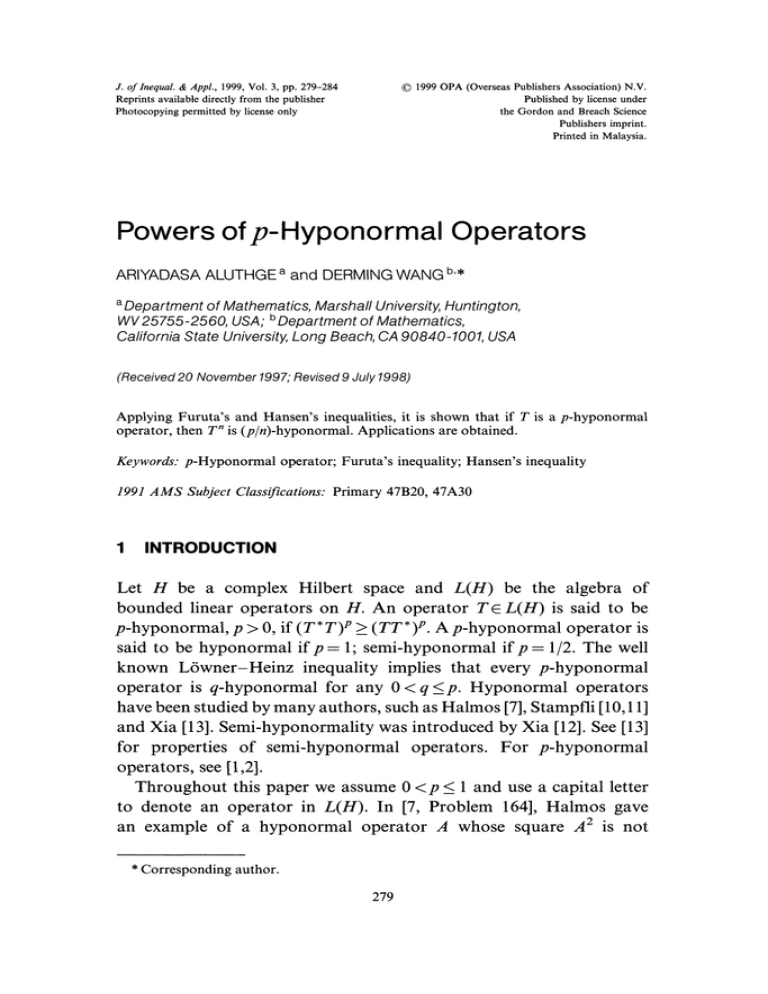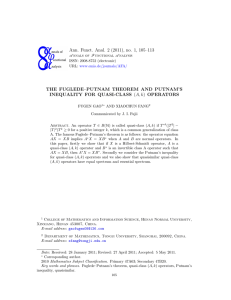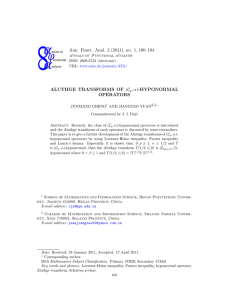Document 10943939
advertisement

(C) 1999 OPA (Overseas Publishers Association) N.V.
Published by license under
the Gordon and Breach Science
Publishers imprint.
Printed in Malaysia.
J. of Inequal. & Appl., 1999, Vol. 3, pp. 279-284
Reprints available directly from the publisher
Photocopying permitted by license only
Powers ofp-Hyponormal Operators
ARIYADASA ALUTHGE a and DERMING WANG
a
Department of Mathematics, Marshall University, Huntington,
VVV 25-755-2560, USA," b Department of Mathematics,
California State University, Long Beach, CA 90840-1001, USA
(Received 20 November 1997; Revised 9 July 1998)
Applying Furuta’s and Hansen’s inequalities, it is shown that if T is a p-hyponormal
operator, then T is (p/n)-hyponormal. Applications are obtained.
Keywords: p-Hyponormal operator; Furuta’s inequality; Hansen’s inequality
1991 AMS Subject
1
Classifications: Primary 47B20, 47A30
INTRODUCTION
Let H be a complex Hilbert space and L(H) be the algebra of
bounded linear operators on H. An operator T E L(H) is said to be
p-hyponormal, p > 0, if (T’T)p >_ (TT*) p. A p-hyponormal operator is
said to be hyponormal if p 1; semi-hyponormal if p 1/2. The well
known L6wner-Heinz inequality implies that every p-hyponormal
operator is q-hyponormal for any 0 < q <p. Hyponormal operators
have been studied by many authors, such as Halmos [7], Stampfli [10,11]
and Xia [13]. Semi-hyponormality was introduced by Xia [12]. See [13]
for properties of semi-hyponormal operators. For p-hyponormal
operators, see [1,2].
Throughout this paper we assume 0 < p < and use a capital letter
to denote an operator in L(H). In [7, Problem 164], Halmos gave
an example of a hyponormal operator A whose square A 2 is not
* Corresponding author.
279
A. ALUTHGE AND D. WANG
280
hyponormal. Here we use Furuta’s [5] and Hansen’s [6] inequalities to
show that if T is p-hyponormal, then T2 is (p/2)-hyponormal. In fact,
we will show that for any positive integer n, the operator T n is (p/n)hyponormal. Applications of our result are also obtained.
2
THE RESULT
LEMMA (Furuta’s inequality [5]) If A >_ B >_ 0, then the inequalities
(BrAPBr) 1/q
B (p+2r)/q
and
A(p+2r)/q >_ (ArBPAr) 1/q
holdfor p, r >_ 0, q _> with (1 + 2r)q >_ p + 2r.
LEMMA 2 (Hansen’s inequality [6]) IfA >_ 0 and [[B][ _< 1, then
(B*AB)p >_ B*APB
forO<_p< 1.
THEOREM
Let T be a p-hyponormal operator. The inequalities
(Tn* Tn)P/n >_ (T’T)p >_ (TT*)p >_ (TnTn*)p/n
hold for all positive integer n.
Proof Let T= UITI be the polar decomposition of T. For each
positive integer n, let An=(Tn*Tn) p/n and Bn=(TnTn*)p/n. We will
use induction to establish the inequalities
An >_ A1 >_ B1 >_ Bn.
(1)
The inequalities (1) clearly hold for n 1. Assume (1) hold for n k.
The induction hypothesis and the assumption that T is p-hyponormal
imply
U*AkU >_ U’A1 U >_ A1.
POWERS OF p-HYPONORMAL OPERATORS
.
Let Ck
281
u*Akk/P U)p/k. Hansen’s inequality implies Ck >_ U*AkU >_
A Thus
Ak+l
(T *+ Tk+l) (p/k+l)
T* T *k Tk) T) (p/k+l)
([TIU*Akk/PUIT[) (p/k+l)
(A1/2prk/p
""k All/2p)(p/k+I)
>_A
by Furuta’s inequality. On the other hand, the induction hypothesis
implies
Bk <_B1 <_A1.
Thus
_
where the inequality follows from Furuta’s inequality. Therefore,
Ak+l
A1 >_ B1 >_ Bk+l
and hence, by induction, inequalities (1) hold for n > 1. The proof is
complete.
COROLLARY
If the operator T is p-hyponormal, then T" is (p/n)hyponormal.
Concrete examples of non-hyponormal p-hyponormal operators are
hard to come by. In [12], Xia gave an example of a singular integral
operator which is semi-hyponormal but not hyponormal. Corollary
allows us to give another example of a semi-hyponormal operator which
A. ALUTHGE AND D. WANG
282
is not hyponormal. Let A be the operator in Halmos’ [7, Problem 164].
Thus, A is hyponormal but A 2 is not hyponormal. By Corollary 1, A 2 is
semi-hyponormal. Moreover, A n is (1/2n)-hyponormal.
3
APPLICATIONS
In [10, Theorem 5], Stampfli proved that if T is hyponormal and T n is
normal for some positive integer n, then T is normal. Stampfli’s result
had been extended by Ando [3] to the case where T is paranormal.
Although not as broad as Ando’s extension, Theorem can easily be
used to extend Stampfli’s result to p-hyponormal operators as follows.
COIOILARY 2 Let the operator T be p-hyponormal.
then T is normal.
Proof By Theorem
Whence
and the assumption that
If T
is normal,
T" is normal,
T’T- TT*. The proof is complete.
In [9, Theorem 7], Putnam proved that if T is hyponormal, and r > 0
is such that rEr(T*T), then there is a z Ea(T) such that Izl =r.
Recently, Ch6 and Itoh [4, Theorem 4] generalized Putnam’s result
to the case where the operator T is p-hyponormal. Theorem can be
utilized to give a generalization of the result of Ch6 and Itoh as follows.
THEOIEM 2. Let T be a p-hyponormal operator and n be a positive
integer. If r >_ 0 is such that r2 cr(Tn* Tn), then there is a z or(T)
such that Izl"-r.
Theorem implies T is (p/n)-hyponormal. Therefore, by
[4, Theorem 4], there is a w or(T") such that Iwl =r. Since
{z": z a(T)}, there is a z E or(T) such that z"- w. Clearly Izl"- r and
Proof
the proof is complete.
As an extension of the well-known Putnam’s area inequality for
hyponormal operators [8], Xia [13, Theorem XI.5.1] proved the
following Theorem 3 for the case in which T is p-hyponormal with
p _> 1/2 and n 1. In [4, Theorem 5], Ch6 and Itoh extended Xia’s result
to p-hyponormal operators with 0 < p < 1/2.
POWERS OF p-HYPONORMAL OPERATORS
THEOrtEM 3 Let T be p-hyponormal.
for some positive integer m, then
ii(Tn, zn)p/n (TnTn.)p/nll <_
283
If or(T) C_ {rei: 0 < 0 < 2Trim}
nPTr JJ p2p-1
dpdO
(r)
for positive integers n < m.
Proof By Theorem 1, T n
is (p/n)-hyponormal. It follows from
[4, Theorem 5] that
I](Tn*Zn)p/n (ZnZ"*)P/nll <-
PnTf JY" r2(p/n)-I
drdqS.
o’(Z
Since cr(T
{pneinO: peiO E or(T)), the result follows by the substitutions r pn and b nO.
Acknowledgment
This paper was written while the first author, on sabbatical leave from
Marshall University, was a visiting adjunct professor at the Department
of Mathematics, California State University, Long Beach, Fall, 1997.
He wishes to express his deep gratitude to his host for warm hospitality
and support.
References
[1] A. Aluthge, On p-hyponormal operators for 0 < p < 1, Integr. Equat. Oper. Th., 13
(1990), 307-315.
[2] A. Aluthge, Some generalized theorems on p-hyponormal operators, Integr. Equat.
Oper. Th., 24 (1996), 497- 501.
[3] T. Ando, Operators with a norm condition, Acta Sci. Math.;33 (1972), 169-178.
[4] M. Ch6 and M. Itoh, Putnam’s inequality for p-hyponormal operators, Proc. Amer.
Math. Soc., 123 (1995), 2435-2440.
[5] T. Furuta, A > B > 0 assures (BrAPBr) TM >_ B(p+2r)/q for r > 0, p > 0, q > with
(1 + 2r)q > p+ 2r, Proc. Amer. Math. Soc., 101 (1987), 85-88.
[6] F. Hansen, An operator inequality, Math. Ann., 246 (1980), 249-250.
[7] P.R. Halmos, A Hilbert Space Problem Book, Van Nostrand, Princeton, New Jersey,
1967.
[8] C.R. Putnam, An inequality for the area ofhyponormal spectra, Math. Z., 116 (1970),
323-330.
[9] C.R. Putnam, Spectra of polar factors of hyponormal operators, Trans. Amer. Math.
Soc., 188 (1974), 419-428.
284
A. ALUTHGE AND D. WANG
[10] J.G. Stampfli, Hyponormal operators, Pacific J. Math., 12 (1962), 1453-1458.
[11] J.G. Stampfli, Hyponormal operators and spectral density, Trans. Amer. Math. Soc.,
117 (1965), 469-476.
[12] D. Xia, On the nonnormal operators-semihyponormal operators, Sci. Sininca, 23
(1980), 700-713.
[13] D. Xia, Spectral Theory of Hyponormal Operators, Birkhiuser Verlag, Boston, 1983.



